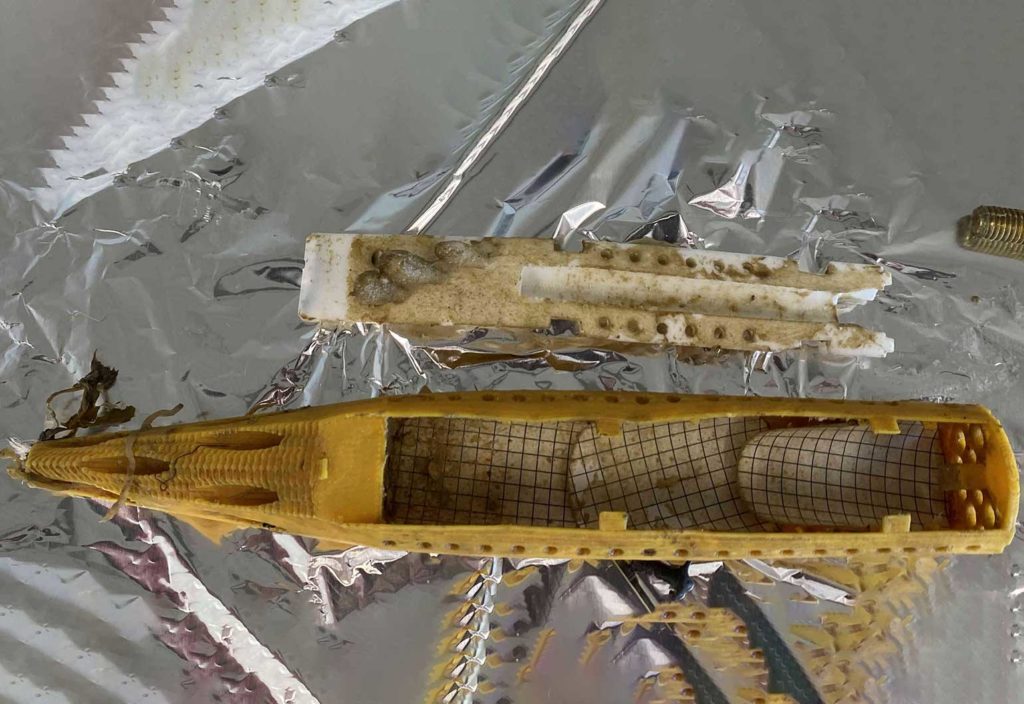A simple, cost-effective and portable device, shaped like a torpedo, has been successful in detecting SARS-CoV-2 in wastewater in Victoria and is now being rolled out overseas.
Dubbed the Torpedo Passive Sampler and the ‘sewage submarine’, it was developed by researchers at Monash University’s Department of Civil Engineering, in partnership with a consortium of universities and industry locally and internationally.
The sampler is constructed of cotton buds, medical gauze swabs and lab grade electronegative membranes encased in a narrow, 3D-printed shell, and can detect the coronavirus on an individual lot or in a suburb or city.
Lead researcher David McCarthy, an Associate Professor of Engineering at Monash University, said the portability and size of the ‘torpedo’ means health authorities can narrow down the areas where people are likely to be shedding the virus.
“Above all, the ‘torpedo’ is cheap — roughly $20 each compared to more than $5000 for an automatic sampler such as HACH SD900 — easy to use, and provides more consistent results than other sampling methods,” he told create.
How it works
Researchers began by developing something that looked like a little boat, but quickly realised that, because of its width, the device caught a significant amount of material in the sewage.
“It became quite clear that the shape had to be more [like a] tear drop,” McCarthy said.
“Then we slowly came to the conclusion that we needed a bullet shape — one that almost acted like a torpedo in the water.”
The Torpedo Passive Sampler is simply thrown into a sewer for between 24 and 48 hours and tied off using a rope that is attached to an anchor point. It then acts almost like a fishing net, absorbing traces of the SARS-COV-2 virus as it passes.
McCarthy said there is evidence it also absorbs E. coli, Bacteroides HF183, FRNA coliphages and Pepper Mild Mottle Virus.
The device is weighted so that it sinks during low flows but, during high flows, becomes resuspended in the water column. The water flows through the device by specifically designed holes at the front, which allows water to penetrate, but not too much toilet paper.
In the initial study, the passive samplers were placed across eight study sites in Victoria, from systems that collected the wastewater of 260 residents and staff near an aged care facility, to Melbourne’s largest sewage treatment plant that pools wastewater from more than two million residents.
Other applications
As the intellectual property is open, the 3D-printing files can be shared with governments and health professionals across the world. More than 2500 have been issued across Australia and to New Zealand, Canada, the United States and the Netherlands and, soon, Indonesia.
“There are now a lot of new ideas now about how to use passive sampling, or rather these torpedo devices,” McCarthy said.
“We have begun using them to detect sewage cross connections in stormwater drains, and have recently finished a trial of detecting illegal sewage dumping into stormwater drains.
“We have also begun using them in larger creeks and rivers, to begin understanding the sources of faecal contamination in these waterways.”
McCarthy the discovery is ground-breaking because it can fundamentally change the way we detect critical virus spread in the community, and help with targeted healthcare actions.
“Plus, we can also offer these solutions to communities globally that are in desperate need of cheap and easy to use methods to help curb the spread of this virus,” he said.
The idea for developing passive sampling technology for monitoring COVID-19 in wastewater initially came from Melbourne Water’s Dr Nicholas Crosbie, who in turn was inspired by the work of Dr Brendan Moore (inventor of the so-called ‘Moore Swab’ in 1948).

